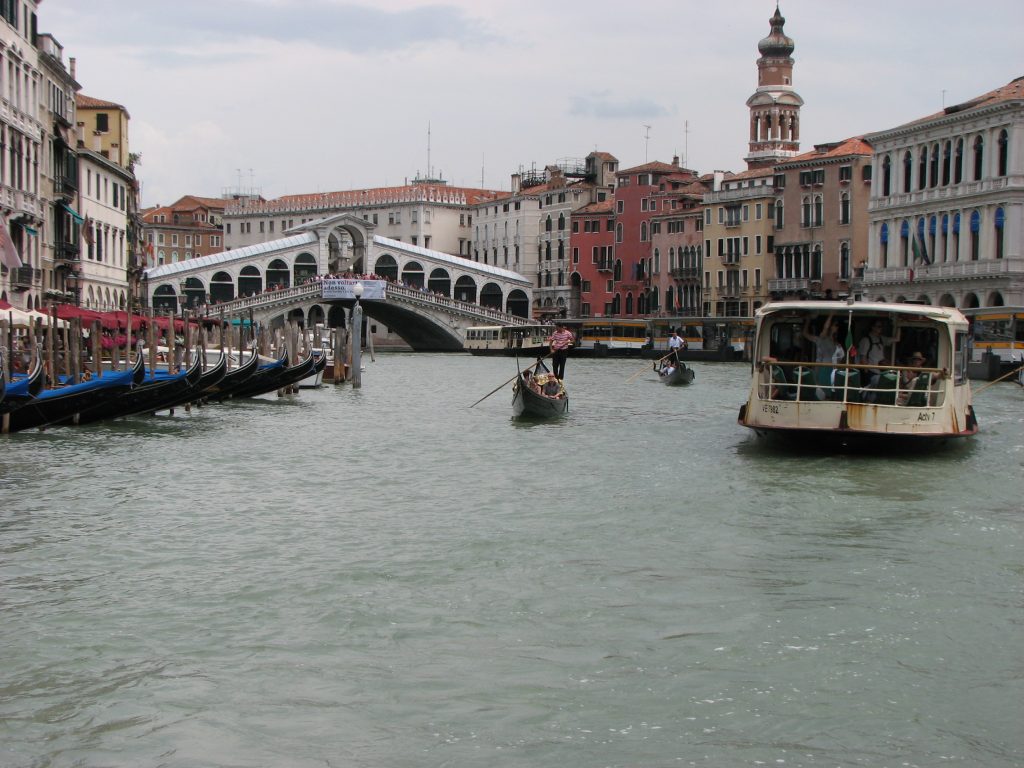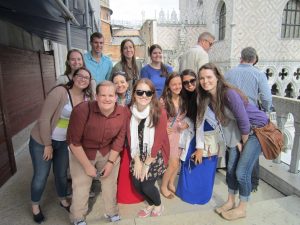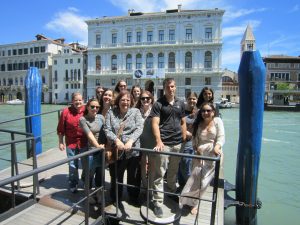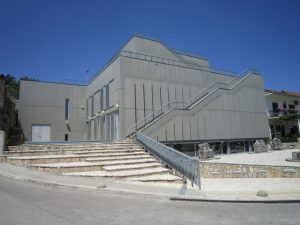Take a look at the photos from our 2014 trip, May 13-27!
We arrived in Venice on May 14 a sleepy group of travelers. After checking in to our hotel, we enjoyed a Venetian feast at the Ristorante San Trovaso of risotto, baccalà mantecato, calamari, grilled eggplant, baby green beans, and tiramisù.
Refusing to be held back by jet lag, we forged on to the important churches of the Gesuati, Sta. Maria della Salute, and San Giorgio Maggiore for an introduction to the art and architecture, geography, and “myth” of Venice.
What a great photo Jenna took of our group on the steps on the Salute on our arrival day!
While in San Giorgio Maggiore, we studied Tintoretto’s Last Supper (1594) to the right of the high altar, then admired the Baroque work of the monks’ choir stalls.
 A few hours later we wait at Palladio’s San Giorgio Maggiore (1566-1610) for the vaporetto (that’s a bus-boat) to take us back to our neighborhood of Dorsoduro before our first full day in Venice tomorrow.
A few hours later we wait at Palladio’s San Giorgio Maggiore (1566-1610) for the vaporetto (that’s a bus-boat) to take us back to our neighborhood of Dorsoduro before our first full day in Venice tomorrow.
The Grand Canal is the main route through the city.
The vaporetto arrives at the pontile, the stop, and passengers board.
Here’s our group posing in the Giardini Reali on the Grand Canal, Venice, May 15, our first full day in Venice. We’re on our way to Piazza San Marco to examine the work of Jacopo Sansovino, study the Porta della Carta, visit the Palazzo Ducale and the Basilica of San Marco, and enjoy the sites of the Piazza.
We couldn’t have asked for a bluer sky… 
And who knew there were five Tetrarchs???!!! 
Oh I get it…there are two sets of four:
Professor Houghtalin explains this extraordinary phenomenon.
 Our tour of San Marco includes visits to the Treasury, the Pala d’Oro at the High Altar, and the museum over the narthex entrance with amazing views into the nave of San Marco as well as the vault mosaics. In the museum you will see the original four horses from the façade. These horses were likely part of an ancient Roman quadriga chariot, perhaps from the Arch of Trajan in Rome. At some point in their history they were taken to Constantinople, where they were displayed in the hippodrome. During the Fourth Crusade (1204) when Constantinople was sacked by Christian knights from Europe, they were looted and brought to Venice. In 1797 Napoleon had them removed from San Marco and taken to Paris…once again war booty of a conquering army. After Napoleon’s defeat in 1815, the gilded bronze sculptures were returned to San Marco. The originals are now in the museum…with copies on the exterior. A complicated history….
Our tour of San Marco includes visits to the Treasury, the Pala d’Oro at the High Altar, and the museum over the narthex entrance with amazing views into the nave of San Marco as well as the vault mosaics. In the museum you will see the original four horses from the façade. These horses were likely part of an ancient Roman quadriga chariot, perhaps from the Arch of Trajan in Rome. At some point in their history they were taken to Constantinople, where they were displayed in the hippodrome. During the Fourth Crusade (1204) when Constantinople was sacked by Christian knights from Europe, they were looted and brought to Venice. In 1797 Napoleon had them removed from San Marco and taken to Paris…once again war booty of a conquering army. After Napoleon’s defeat in 1815, the gilded bronze sculptures were returned to San Marco. The originals are now in the museum…with copies on the exterior. A complicated history….
Another group view….
…and this is what we saw from the upper loggia of San Marco… 
First thing Friday morning (May 16)…we journey along the Grand Canal to the Rialto Bridge for window shopping (and some purchasing) followed by a visit to the Pescheria, Venice’s famous fish market.  This was followed by a journey via traghetto back across the Grand Canal (yes, that’s Professor Houghtalin)…
This was followed by a journey via traghetto back across the Grand Canal (yes, that’s Professor Houghtalin)…
…to peer into the courtyard of the Ca’ d’Oro. FYI: there were 15 of us in this traghetto! The very reserved Venetian gentleman in the back said: “Sit down!” We sat.
Saturday, May 17 was full of art: visits to the Accademia, the Ca’ Rezzonico, and the Frari. There’s nothing like teaching with the work of art in front of you!
And the group at the Ca’ Rezzonico.
And getting on axis with Titian’s Assumption (1516-18) at the Frari.
A day full of art…but also full of chocolate!
Decisions decisions….
Oh Vizio Virtù…..
This says it all:
Sunday, May 18 — off to Verona, Vicenza, and the villas!
 Here we are at the Villa Cordellina Lombardi, built by Giorgio Massari in 1742. Giambattista Tiepolo frescoed the main hall in 1743 with scenes of Scipio Africanus, Alexander the Great, and Fame. We were so close to the frescoes we could study his technique and the way he transferred drawings to the wet fresco.
Here we are at the Villa Cordellina Lombardi, built by Giorgio Massari in 1742. Giambattista Tiepolo frescoed the main hall in 1743 with scenes of Scipio Africanus, Alexander the Great, and Fame. We were so close to the frescoes we could study his technique and the way he transferred drawings to the wet fresco.
Palladio’s Villa La Rotonda (from 1567) offered us an opportunity to observe perfection…
 …enjoy nature, relax, and learn about Humanism in Venetian villa life.
…enjoy nature, relax, and learn about Humanism in Venetian villa life.
May 19 — off to Croatia by coach. Is that a microphone Professor Houghtalin is holding?
May 20 — Is this the Colosseum in Rome? No! It’s the great amphitheater in Pula, Croatia!
This amazing structure got us talking about ancient Roman architecture, building materials, roads, and of course gladiatorial competitions…one of the on-site presentations today.
…and we must have time for photos…
before visiting the Museum of Ancient Roman Pula beneath the amphitheater.
And what else is there in Pula?

Pula’s ancient Roman wall restored in the middle ages with ancient materials — column drums and sculpted reliefs.
Ancient Roman gates, arches, temples, and walls, as well as Byzantine ruins and medieval palaces.
From Pula we traveled on to Zadar, a town on the coast with ancient Roman, Byzantine, and medieval sites.
But first we stop at Opatija, a fascinating late 19th- and early 20th-c. resort town on the Adriatic — interesting architecture and a rocky beach along cliffs! 
The Austrian emperor Franz Josef I, Irish novelist James Joyce, American dancer Isadora Duncan, Russian writer Anton Chekhov, and Italian composer Giacomo Puccini were among those who came to fin de siècle Opatija.
Roman — Byzantine — Kingdom of Hungary — Republic of Venice — Italy — Yugoslavia — Croatia — Zadar has a fascinating history and its art and archeology is evidence of a city richly embellished by these many cultures. Zadar was a major port throughout antiquity and the middle ages, and it was a strategic maritime site for the Venetian empire from 1409. After WWI, Zadar became part of Italy, then in 1947 it was part of Yugoslavia, and today is one of the most important cities along the Adriatic.

Interior of St. Donat. Note how ancient Roman materials were reused in the 9th-c. structure — a fluted column became a base and slices of columns (drums) can be seen in the foundation at left. We saw that in the medieval wall at Pula, as well.

See the Lion of St. Mark? The Republic of Venice made sure visitors to Zadar — and its own citizens — knew who was in charge. Michele Sanmichele, 1573.
From Zadar we travel to Burnum, an ancient Roman site that is just beginning to be excavated and studied.  Here we are listening to Professor Houghtalin as she recreates the sites and sounds of a Roman amphitheater on the edge of the Empire.
Here we are listening to Professor Houghtalin as she recreates the sites and sounds of a Roman amphitheater on the edge of the Empire.
We arrive in Split, an ancient city…but the grocery store is in a medieval palace!
The following morning, we make our approach to Diocletian’s palace-villa. The Golden Gate is one of many entrances to the city. 
We aim for the great Peristyle in Diocletian’s palace where the emperor stood at the top of the steps in the central arch.
An on-site report about the great palace.
Before leaving the palace for dinner, we visit Ivan Meštrović’s monumental bronze statue of Gregory of Nin (1929), the 10th-century bishop of Nin who introduced the Croatian language into religious services in opposition to the authorities in Rome. It’s good luck to rub the foot of the statue.
We concluded the day with a great meal of Croatia specialties: grilled chicken and sausages, seafood risotto, fresh vegetables and french fries, salads, olives, and bread.
From Split, we take a short side trip to Trogir, once a Venetian colony. 

The medieval and Renaissance buildings are everywhere…and still inhabited.
We also visit Salona, where Diocletian was born. This is an archaeological site not far from downtown Split.
You can see that there is a great deal of archaeological evidence here for studying the Roman and Early Christian city of Salona. The image at right shows the theater…the cars on a freeway just beyond!
We had several reports, walked the Roman roads, and enjoyed the views.
 Needless to say, Professor Houghtalin was in her element.
Needless to say, Professor Houghtalin was in her element.
Leaving Split, we then traveled to the town of Vid, once an ancient Greek city then the Roman colony of Narona, an important trade center. A museum has been built here to protect the recently discovered Augusteum, both the architecture as well as the statues found here.
From Vid we traveled to Dubrovnik via Mostar, Bosnia-Herzegovina. Mostar developed i the 15th and 16th centuries as a city on the Ottoman frontier. Much of this area was destroyed in the war following the dissolution of Yugoslavia. The Old Bridge, or Stari Most, was built in 1566 by orders of Suleiman the Magnificent, and was immediately recognized to be a technological feat and an architectural masterpiece. The Old Bridge, considered a symbol of the many cultures that lived and worked together in Mostar, was rebuilt in 2004. The bridge area is now a UNESCO World Heritage Site.
We arrive in Dubrovnik in the late afternoon, settle in to our hotel; some wander along the cliff side promenade above the pebble beach while others take a dip.
 The next morning we visit the old medieval city of Dubrovnik, a UNESCO World Heritage Site, and walk along the City Walls.
The next morning we visit the old medieval city of Dubrovnik, a UNESCO World Heritage Site, and walk along the City Walls. 
For centuries, Dubrovnik was an independent city-state, and the massive fortifications surrounding the city protected it. The 6,360′ of walls reach a height of 82′, and are among the largest and most complete in Europe. We have our final presentation here, and pause for LOTS of photos!
The evening’s sunset was beautiful…
 for our farewells before we head to our rooms, pack, and prepare to return home.
for our farewells before we head to our rooms, pack, and prepare to return home.




































































